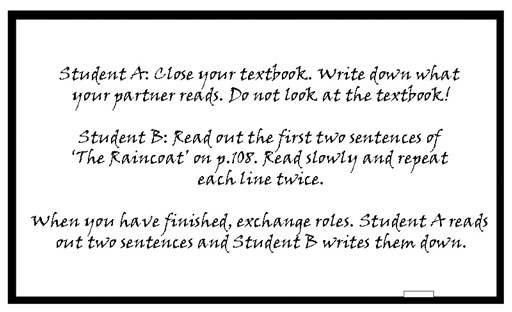Use 'Print preview' to check the number of pages and printer settings.
Print functionality varies between browsers.
Printable page generated Saturday, 22 November 2025, 2:35 PM
TI-AIE: Supporting speaking in English: pair and groupwork
What this unit is about
This unit is about classroom activities that will help your students to speak independently in English. Being able to speak English well is a skill that will benefit your students in life outside and beyond school. In order to achieve this, your students need to learn to express themselves in English using the language for their own purposes: to discuss an issue, hold a conversation or gain some information. They need to take part in a variety of speaking activities, including ones that allow them to develop the skills they need for real-life communication. They also need the opportunity to speak using their own words. If words and phrases are always provided for them, or if they recite memorised words and phrases, they will have difficulties when they come to speak by themselves.
This unit gives you some ideas about how to run a variety of activities in your classes that support students in developing the skills necessary to take part in real life. It shows how you can provide opportunities for students to speak in English as much as possible by using pair and groupwork. Pair and groupwork help you to create situations where students have to use English to communicate with each other. There are challenges involved in using pair and groupwork for language practice, so this unit explores how other teachers organise and manage these kinds of speaking activities.
When students first start speaking English in pairs and groups, they need a lot of support. This can begin with giving them the text to say, such as reading aloud from the textbook, repeating phrases and sentences (see the unit Using more English in your classroom), or dictating a passage to a classmate (discussed below). As they gain confidence, you can give them less support and more space to communicate using their own words and ideas through speaking activities such as role play (see the unit Building your students’ confidence to speak English ), an interview or discussion (discussed below).
What you can learn in this unit
- Ways to use pair and groupwork for speaking activities.
- Creating opportunities for purposeful talk in English.
- Organising and managing speaking activities with a large class.
1 Pair and groupwork speaking activities
Students may need to speak in English in all kinds of situations in their lives beyond school. In order to be fluent and confident, they need to practise. However, many students do not have enough opportunities to do this; the only place where they can practise speaking English is in their classes. This means that you need to create opportunities to speak in English for real purposes, so that students use the language to communicate with you and with each other.
You may be thinking that it is difficult to give all your students the opportunity to speak in class, especially if you have a large number of students. One way that you can give all of your students the chance to speak is by organising them into pairs or small groups (for example, of three or four students) to talk with each other (Figure 1).
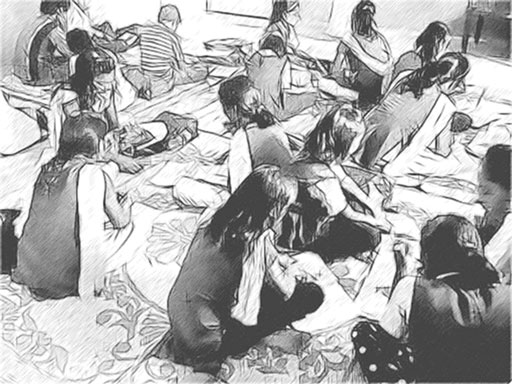
There are many advantages of using pair and groupwork for learning:
- they allow students to learn from each other
- students at different levels can help and support each other
- they can be especially beneficial for practising speaking in English.
Pair and groupwork offer a safer environment for students to try out their speaking because fewer people hear them but all students have opportunities to speak and listen. This enables students to develop confidence in their speaking in English. You may want to have a look at key resources, ‘Using pair work’ and ‘Using groupwork’.
Pair dictation as a step towards communicating in English
Pair dictation is a simple way to get your students used to speaking and listening to each other in English. This activity is not purely communicative, because students are not creating meaningful sentences on their own. However, the students who are speaking get useful practice in pronunciation and the students who are listening and writing also practise spelling and punctuation. These skills help them to develop their confidence and their ability in communicating in English in real life.
Case Study 1: Ms Dutta uses pair dictation for her students to practise speaking English
Ms Dutta recently attended a training session about the importance of giving students the opportunity to speak English in class. At the session, she learned about using pair and groupwork.
I teach Class IX, and we are working through Chapter 8 of the NCERT textbook Beehive. In the last class we reached page 108, which has the following dictation activity:
‘The Raincoat’
After four years of drought in a small town in the north-east, the vicar gathered everyone together for a pilgrimage to the mountain, where they would pray together and ask for the rain to return.
The priest noticed a boy in the group wearing a raincoat.
‘Have you gone mad?’ he asked. ‘It hasn’t rained in this region for five years, the heat will kill you climbing the mountain.’
‘I have a cold, father. If we are going to ask God for rain, can you imagine the way back from the mountain? It’s going to be such a downpour that I need to be prepared.’
At that moment a great crash was heard in the sky and the first drops began to fall. A boy’s faith was enough to bring about a miracle that not even those most prepared truly believed in.
Normally, I read dictations from the textbook aloud, and students listen and write. However, in the training session I learned that the teacher does not always have to be the person who is speaking in class. I realised that my students could be the ones who give the dictation. I thought they could do this in pairs. One student would read out the text, and the other would listen and write it down.
I told my students to make pairs with the person next to them. There were some students left over at the end of some benches, who made groups of three instead of pairs. Then I told my students to begin dictating the passage to their partner(s). I moved around the classroom, and noticed that most of the students were having problems. They didn’t know what to do, and they were just reading the passage. I realised that my instructions hadn’t been clear. I told everyone to stop, and decided to try again.
This time, I told the groups, ‘Decide who is Student A and who is Student B’. (Groups of three had two students with the same letter.) I gave them one minute to decide. Then I said ‘Student As, raise your hands. Student Bs, raise your hands’. This way I knew that everyone was clear about who was Student A and who was Student B. Next, I gave the class instructions for the activity and wrote them on the blackboard.
I made sure that everyone understood the instructions by getting them to say what they needed to do in their home language. I told my students, ‘You have ten minutes for the pair dictation.’ The Student As began to dictate the passage to their partners [Figure 2]. As they did the activity, I walked around the classroom, listening to the pairs and checking that everyone was doing the activity correctly. Some of them were still not sure, so I explained again. Most of them were enjoying the activity and it was working well. It was good to hear so many of my students speaking in English.
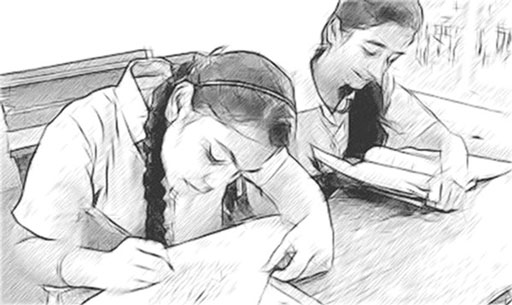
As I listened, I heard that some of the students made mistakes with pronunciation. I didn’t interrupt them. I made a note of the most common pronunciation mistakes and decided that I could correct these mistakes with the whole class after the activity. I thought that my notes could be useful for assessment (see the unit Supporting language learning through formative assessment).
When nine minutes had passed, I told the students, ‘You have one more minute.’ When ten minutes had passed, some of the students had not quite finished reading, but I knew that everyone had had a chance to dictate some sentences. It was not possible for me to check all of their work, so I asked them to check and correct it themselves by comparing it to the passage in the textbook. This helped them to see where they had problems with spelling or punctuation.
The activity went well on the whole, although I realised that I need to give clearer instructions for these kinds of activities. I am going to use more pair work in my classes. I think that the more I use it, the more students will get used to it.
Activity 1: Using a pair dictation
You can use this activity with any short passage and with any class. Follow these steps to try a pair dictation exercise with your students:
- Before class, find a short passage (such as a paragraph) that your students could use for dictation. Make sure that the text isn’t too complicated in terms of vocabulary and punctuation.
- Organise your students into pairs (for example, with the person next to them). Check that everyone is in a pair. Anyone left over should join a pair to make groups of three.
- Give students instructions for the pair dictation, using English if you can. You could write the instructions on the blackboard. Check that they understand the instructions (for example, by asking students to say what they have to do in their home language).
- Make sure that students switch roles at some point, so that the one who was speaking now has to write and the one who was writing now has to speak.
- Give a time limit for the activity, such as ten minutes.
- Walk around the room as students work. Check that they understand what they are supposed to be doing and help where necessary or make notes (for example, of common pronunciation or spelling problems). Check that all students are involved in the activity.
- When the time is up, tell the students to stop working.
- Tell the students to check their work with the textbook.
- Provide feedback on any common mistakes (for example, with pronunciation, spelling or punctuation) that you noticed.
Pause for thought Here are some questions for you to think about after trying this activity. If possible, discuss these questions with a colleague.
|
Students need to understand what they need to do before they work in pairs or groups. Writing instructions on the blackboard is a good idea so that students can refer to them as they work. You could also demonstrate the activity with the whole class first, getting two students to practise the activity in front of the whole class.
If not all of your students spoke, try to find what the problems are. Are your students afraid of making mistakes? Do they find working in pairs uncomfortable? Students may find pair and groupwork difficult at first. It can help if you tell them about the benefits, and that it will get easier with practice. Use pair and groupwork as often as you can and students will soon get used to it. See Resource 1, ‘Involving all’, for more on involving all students.
2 Creating opportunities for real-life communication in English
It is important to give students as many opportunities to speak in English as possible in English classes. But in many speaking activities, students are reading aloud or speaking set phrases that they have learned. These activities also do not require students to speak their own ideas or formulate sentences to share their thoughts.
When we speak in real life, we usually share information or ideas that are new to the listener. For example, you might give some information about a student to your headteacher, or you might tell your friends about something that happened to you on your way home from work.
Good speaking activities are modelled on real-life situations where information is exchanged. In such activities, students have to use language to communicate what they want to say.
Examples of speaking activities that develop communication skills are role plays, interviews and discussions – see Resource 2 for an example of a role play activity. In the activities and case studies that follow, you will look at interviews and discussions.
Pair or groupwork in which students conduct interviews with each other can be a good way to use English to communicate. One student can pretend that they are a journalist, while the other can be the interviewee (they could be famous movie starts, sports heroes, musicians, a local person, etc. …). While the students are playing roles, they are participating in an activity that is modelled on a real-life situation in which one person asks questions and another one gives a reply to communicate information.
Case Study 2: Mr Sampath helps his students to do interviews in small groups
Mr Sampath teaches English to Class IX at a government secondary school.
I teach Class IX, and we recently read a passage about Santosh Yadav, a woman who struggled against the odds to climb Mount Everest [see the NCERT Class X textbook Beehive, Chapter 8 – ‘Reach to the Top’]. She is a courageous, determined young woman, and I thought it would be interesting to use the character for an interview activity.
After reminding students about the passage, I told them to imagine that they were journalists, and they were going to interview Santosh Yadav, the climber. I asked the whole class to think of some questions they would ask and a few came up with some ideas. I wrote them on the board:
I then organised the class into pairs (with students working with the person sitting next to them) and told them to write as many questions as they could for Santosh. I encouraged them to be imaginative. I gave them a time limit for writing questions – about eight minutes. As they started writing questions I walked around and helped those who needed it, correcting some mistakes, and suggesting more inventive questions, saying:

I quickly made sure that each pair had written some questions, and then I told them to stop writing. I told my class that they were going to do the interviews, and I asked each alternate row to turn around on their benches so that the students faced each other, and gave some more instructions.
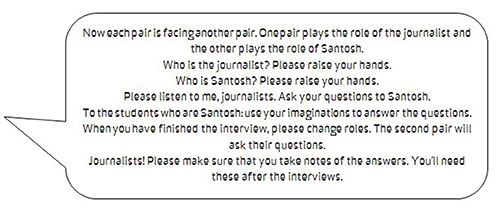
Students started the interviews [Figure 3]. I moved to the back of the room to listen to a group. As I listened, I noticed that one girl was not participating – her classmate was answering all of the questions. I told them that they must take it in turns to answer questions, and that her classmate could help her with words when she was stuck.
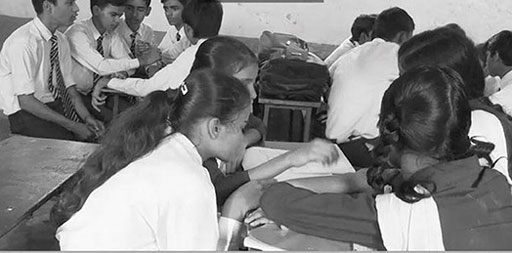
I then listened to a group in the middle of the room. I noticed that they were using their home language to answer the questions. I asked them why, and they said that they didn’t know a word they wanted to use in English. I gave them the translation of the word, and told them to try to use as much English as they could – even if they didn’t know a word. I also told them to note down any words they didn’t know, to ask me later or look them up in a dictionary.
Then I realised that the room was quite noisy. I saw that some groups were being noisier than the others, so I moved across to them and told them to speak more quietly. Sometimes it is enough to catch the attention of a group and to use a gesture to quieten things down.
I noticed that many students were making mistakes. I knew that if I interrupted, I would discourage them from speaking – and the whole purpose of this activity is to get students speaking in English. Instead, I made a note of some common mistakes and decided that I could review these problems in another class.
After ten minutes I saw that many groups were finishing their interviews, so I decided to end the activity. I started counting down from ten to zero. By the time I reached zero, the groups were quiet, and had stopped talking. I asked students to use their notes from the interview to write a report about Santosh.
Activity 2: Try an interview activity in the classroom
Follow these steps and try using interviews in your classroom the way that Mr Sampath did in Case Study 2. This will allow your students to practise communicating in English:
- Select a person to be interviewed. This could be somebody from a passage in the textbook (as in Case Study 2), a fictional character, or any famous person suggested by the students; for example, a film star, a sports star, a local celebrity and so on. If the character to be interviewed is an interesting one for the students, they are more likely to be motivated.
- Ask the students to give some questions that they might want to ask, and write three to five suggestions on the blackboard. Encourage them to ask questions that they don’t know the answers to, and to use creativity and imagination. Examples might be:
- How many brothers and sisters do you have?
- What did you want to be when you grow up?
- How did you feel when you did [whatever they did]?
- Tell the students to imagine that they are journalists and to write down questions. Give them a time limit of, say, ten minutes.
- Move around the classroom as the students write, checking and correcting work, helping, and encouraging interesting questions.
- Tell alternate rows to turn around so that they are facing the row behind. Tell pairs facing each other to make a group of four. Make sure any extra students are incorporated into a group.
- Tell the students that one pair of each group should take the role of the journalist, while the other pair is the interviewee. Tell them that they should exchange roles once the first interview is finished. Journalists must take notes of the interviews.
- Check that everyone understands their roles and what they need to do. Give a time limit of ten minutes for the interviews.
- As the groups conduct the interviews, move around the room and listen, helping where necessary.
- After around ten minutes, end the activity quickly using some routine (for example, counting down from ten to zero).
Pause for thought There are many benefits to using pair and groupwork. However, they also have their challenges, especially when used with large classes. After trying this activity with your students, think about what happened in your classroom:
|
In Activity 3, you will explore these questions further.
Activity 3: Challenges and possible solutions in using pair and groupwork for speaking activities
Read some teachers’ comments about the challenges of using pair and groupwork for speaking activities. They are marked A, B, C and D:
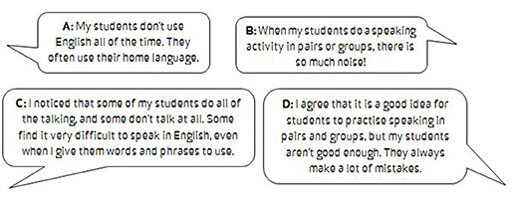
Now read some advice from some other teachers. Decide which advice goes with which challenge, and write the relevant letter next to it. For example, the first piece of advice helps teachers who are worried about noise (B). When you are ready, check your answers with Resource 3.
| It is up to you to let your students know what an acceptable level of noise is. Move around the room and keep an eye on all the groups and pairs so that you can immediately stop them if some students are getting to loud or not doing the activity. | B |
| Make sure that you provide support for students who are struggling. They may need more help with words or phrases, or more time to plan what they are going to say. | |
| Students could plan with others so that they can help each other. Try to encourage all of your students so that they stay motivated and eager to learn. | |
| Talk to other teachers in the school and your headteacher so that they know why there is noise in your classroom. Make sure that they understand that the noise is a result of active learning and not a lack of discipline. | |
| Don’t worry too much about mistakes. You can make notes and review common problems with the whole class after an activity. | |
| If noise is a problem, agree time limits, or – if you can – go outside to do the activity. | |
| Be positive about mistakes. Remember that the classroom should be a safe place for students to practise – they can learn from their mistakes and rehearse language before they have to use it outside the classroom in ‘real life’. | |
| As you move around the classroom, make notes when students use their home language, and at the end of the activity, you could teach them the English they need. Encourage students to note down the words they don’t know, and to use a dictionary to look the words up in their own time. | |
| Remember that it is natural for students to use their home language or to mix languages. Encourage them to use English as much as they can, but also understand that there are times when students don’t have the language skills in English to express what they want to say, and remember that even some English is better than none. |
3 Moving students towards speaking independently in discussions
As students become more confident at speaking in English, they can carry out activities such as discussions. These give your students opportunities to share and hear opinions. They also give your students the opportunity to speak more independently and express themselves in their own words.
You can do discussion activities with any class or level. Note, however, that you need to choose topics that are appropriate to the level and age of your students, and give more language support to students whose English is weaker. Here are ways in which you can support your students to participate in a discussion in English:
- Give your students something interesting to talk about. Discussions don’t always have to be about serious topics. If you allow students to choose the topic, they may find it easier to talk about, and they will probably be more motivated.
- Give the students some time to prepare what they want to say and the words or phrases that they might need (see the unit Building your students’ confidence to speak English).
- Use small groups where students can support each other. Within the groups, encourage all students to contribute, but don’t expect students to contribute equally to every discussion.
- Keep the discussion short, and don’t expect students to talk at length. Walk around the room and listen as students carry out the activity. If you note that most students have finished, end the activity. It is always better to end an activity before the students have quite finished rather than lettingit drag on for too long. If an activity lasts too long, students become bored and unfocused.
- It can help students to focus and concentrate on the discussion if they know that they are doing something with their ideas later, for example giving a report or a presentation. So you may want to vary your activities by following a discussion activity with a writing activity.
Case Study 3: Ms Aruna directs discussions in small groups
Ms Aruna teaches English in a secondary school. She reflects on how she tried to engage her students in a discussion in English by having them choose the topic.
I teach Class X and in the textbook there are often suggestions for discussions. My students used to find discussions very difficult. I would ask them a question and then ask them to say what they thought. One or two would stand up and give some opinions and then sit down. To be honest, it was always the same students. The others would not express an opinion.
In the end, I would write some sentences on the board for students to say, such as ‘I think it is right to kill animals to save a human being’, or ‘In my opinion, it is not right to kill animals to save a human being’. But I knew that they were just reading my sentences aloud, and not even giving their real opinions. This approach was not really developing their speaking skills.
I decided to try a new approach. I asked my students for some topics that they would like to discuss. We wrote a list on the board and we chose one: ‘Which is the best TV serial on today? Why is it the best? Is it good – or bad – for young people to watch TV serials?’
I wrote some phrases on the blackboard that students could use to express an opinion, and to agree or disagree with each other:

Then I gave the students two or three minutes to make notes of what they wanted to say. I encouraged them to write notes only and not to write a text. Then I gave the students some further instructions:
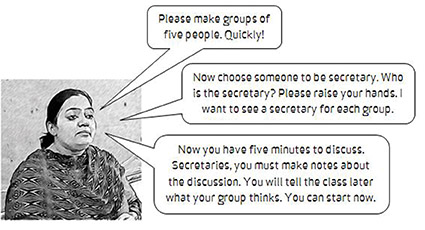
As students discussed, I moved around the room and listened to the discussions. I didn’t join in or correct their mistakes. The discussions were very interesting! I listened to two groups and I made some notes about grammar and pronunciation mistakes.
After five minutes I stopped the discussion and I asked the secretary of some of the groups to give a short report of the discussion to the whole class. Usually students don’t really listen much when others are reading out or speaking, but this time they were all interested to see what everyone thought about their favourite TV serial!
At the end of the class, I reviewed the grammar and pronunciation mistakes. I wrote words that students had pronounced incorrectly on the board, and asked them to repeat the words after me. Then I wrote some sentences with mistakes that the students had made on the board, and asked them to find the mistakes and write the correct sentences in their notebooks.
The students enjoyed the class, and they spoke much more using this approach. Next time, I plan to follow up the discussion with a writing activity so that students can have more time to develop their ideas about the topic.
Activity 4: Try in the classroom – supporting students to participate in group discussions
Follow these steps to carry out group discussions with your students:
- Ask your students to share ideas about a topic to discuss. Write the ideas on the blackboard and ask the students to select a topic, for example by raising their hands to vote.
- Write some useful phrases on the blackboard, including vocabulary if necessary. Give your students a few minutes to make notes about the topic. This gives them time to prepare what they want to say and the words they need. Walk around the room and help students who need it.
- Organise your students into small groups of, say, four or five. Ask each group to choose a secretary who will make notes during the discussion.
- Tell your students to discuss the topic. Give them a short time limit.
- As students discuss, listen to as many groups as you can. You can make notes about their use of English if you like. Try not to interrupt or correct students – you can correct mistakes later.
- When the time is up, tell the students to stop.
- Ask the secretary in each group to give a report on the discussion.
- Give students some feedback about the reports. Respond to what students have said, and remember to be positive. You can deal with mistakes at the end of the activity in another class.
Pause for thought Here are some questions for you to think about after trying this activity. If possible, discuss these questions with a colleague.
|
Remember that speaking in another language is difficult for many students. Be encouraging and give positive feedback. Some students will need more support than others. You can give these students more words and phrases, more time to plan and prepare, or put them with classmates who can help them.
4 Summary
Being able to speak in English is a skill that will be useful for many students in their personal and work lives outside and beyond school. In order to develop this skill, students will need a lot of practice in speaking in English. You can do this by providing as many opportunities as possible for your students to do so. One way of doing this is by getting students to speak English in pairs or small groups. This means that all students have the opportunity to speak at some point in an English class.
You also need to give students a variety of speaking activities, such as interviews and discussions. At first, students may need lots of support and may need to have the language provided for them (such as repetition and pair dictations). Over time, students can move on to activities with less support (such as role plays, interviews and discussions). These kinds of activities will help students to develop the skills that they need in order to take part in real-life conversations in English.
For more ideas for speaking activities, see Resource 4 and the additional resources; for ideas about how to develop your own speaking skills, see Resource 5.
Other secondary English teacher development units on this topic are:
- Using more English in your classroom.
- Building your students’ confidence to speak English.
Resources
Resource 1: Involving all
What does it mean to ‘involve all’?
The diversity in culture and in society is reflected in the classroom. Students have different languages, interests and abilities. Students come from different social and economic backgrounds. We cannot ignore these differences; indeed, we should celebrate them, as they can become a vehicle for learning more about each other and the world beyond our own experience. All students have the right to an education and the opportunity to learn regardless of their status, ability and background, and this is recognised in Indian law and the international rights of the child. In his first speech to the nation in 2014, Prime Minister Modi emphasised the importance of valuing all citizens in India regardless of their caste, gender or income. Schools and teachers have a very important role in this respect.
We all have prejudices and views about others that we may not have recognised or addressed. As a teacher, you carry the power to influence every student’s experience of education in a positive or negative way. Whether knowingly or not, your underlying prejudices and views will affect how equally your students learn. You can take steps to guard against unequal treatment of your students.
Three key principles to ensure you involve all in learning
- Noticing: Effective teachers are observant, perceptive and sensitive; they notice changes in their students. If you are observant, you will notice when a student does something well, when they need help and how they relate to others. You may also perceive changes in your students, which might reflect changes in their home circumstances or other issues. Involving all requires that you notice your students on a daily basis, paying particular attention to students who may feel marginalised or unable to participate.
- Focus on self-esteem: Good citizens are ones who are comfortable with who they are. They have self-esteem, know their own strengths and weaknesses, and have the ability to form positive relationships with other people, regardless of background. They respect themselves and they respect others. As a teacher, you can have a significant impact on a young person’s self-esteem; be aware of that power and use it to build the self-esteem of every student.
- Flexibility: If something is not working in your classroom for specific students, groups or individuals, be prepared to change your plans or stop an activity. Being flexible will enable you make adjustments so that you involve all students more effectively.
Approaches you can use all the time
- Modelling good behaviour: Be an example to your students by treating them all well, regardless of ethnic group, religion or gender. Treat all students with respect and make it clear through your teaching that you value all students equally. Talk to them all respectfully, take account of their opinions when appropriate and encourage them to take responsibility for the classroom by taking on tasks that will benefit everyone.
- High expectations: Ability is not fixed; all students can learn and progress if supported appropriately. If a student is finding it difficult to understand the work you are doing in class, then do not assume that they cannot ever understand. Your role as the teacher is to work out how best to help each student learn. If you have high expectations of everyone in your class, your students are more likely to assume that they will learn if they persevere. High expectations should also apply to behaviour. Make sure the expectations are clear and that students treat each other with respect.
- Build variety into your teaching: Students learn in different ways. Some students like to write; others prefer to draw mind maps or pictures to represent their ideas. Some students are good listeners; some learn best when they get the opportunity to talk about their ideas. You cannot suit all the students all the time, but you can build variety into your teaching and offer students a choice about some of the learning activities that they undertake.
- Relate the learning to everyday life: For some students, what you are asking them to learn appears to be irrelevant to their everyday lives. You can address this by making sure that whenever possible, you relate the learning to a context that is relevant to them and that you draw on examples from their own experience.
- Use of language: Think carefully about the language you use. Use positive language and praise, and do not ridicule students. Always comment on their behaviour and not on them. ‘You are annoying me today’ is very personal and can be better expressed as ‘I am finding your behaviour annoying today. Is there any reason you are finding it difficult to concentrate?’,which is much more helpful.
- Challenge stereotypes: Find and use resources that show girls in non-stereotypical roles or invite female role models to visit the school, such as scientists. Try to be aware of your own gender stereotyping; you may know that girls play sports and that boys are caring, but often we express this differently, mainly because that is the way we are used to talking in society.
- Create a safe, welcoming learning environment: All students need to feel safe and welcome at school. You are in a position to make your students feel welcome by encouraging mutually respectful and friendly behaviour from everyone. Think about how the school and classroom might appear and feel like to different students. Think about where they should be asked to sit and make sure that any students with visual or hearing impairments, or physical disabilities, sit where they can access the lesson. Check that those who are shy or easily distracted are where you can easily include them.
Specific teaching approaches
There are several specific approaches that will help you to involve all students. These are described in more detail in other key resources, but a brief introduction is given here:
- Questioning: If you invite students to put their hands up, the same people tend to answer. There are other ways to involve more students in thinking about the answers and responding to questions. You can direct questions to specific people. Tell the class you will decide who answers, then ask people at the back and sides of the room, rather than those sitting at the front. Give students ‘thinking time’ and invite contributions from specific people. Use pair or groupwork to build confidence so that you can involve everyone in whole-class discussions.
- Assessment: Develop a range of techniques for formative assessment that will help you to know each student well. You need to be creative to uncover hidden talents and shortfalls. Formative assessment will give you accurate information rather than assumptions that can easily be drawn from generalised views about certain students and their abilities. You will then be in a good position to respond to their individual needs.
- Groupwork and pair work: Think carefully about how to divide your class into groups or how to make up pairs, taking account of the goal to include all and encourage students to value each other. Ensure that all students have the opportunity to learn from each other and build their confidence in what they know. Some students will have the confidence to express their ideas and ask questions in a small group, but not in front of the whole class.
- Differentiation: Setting different tasks for different groups will help students start from where they are and move forward. Setting open-ended tasks will give all students the opportunity to succeed. Offering students a choice of task helps them to feel ownership of their work and to take responsibility for their own learning. Taking account of individual learning needs is difficult, especially in a large class, but by using a variety of tasks and activities it can be done.
Resource 2: Resource for role play
This role play is based on a restaurant scene. You could write the menu on the blackboard or get your students to make their own menus for the role play.
Here is the menu of a small restaurant:

A group of young people enter the restaurant and look at the menu. They have to choose two rolls from the given menu. There are some conditions: two of them are vegetarians, and the others prefer to eat non-vegetarian rolls. Two of them have Rs. 50 each and the other three have Rs. 30 each. Take roles in groups of four and you may use the following words and phrases, or your own:
- ‘I prefer … to …’
- ‘I am a …’
- ‘I don’t like …’
- ‘I like …’
- ‘We also … juice.’
- ‘No. That’s not a good idea.’
- ‘Let me suggest …’
Resource 3: Dealing with some of the challenges of using pair and groupwork for speaking activities
| It is up to you to let your students know what an acceptable level of noise is. Move around the room and keep an eye on all the groups and pairs so that you can immediately stop them if some students are getting to loud or not doing the activity. | B |
| Make sure that you provide support for students who are struggling. They may need more help with words or phrases, or more time to plan what they are going to say. | C |
| Students could plan with others so that they can help each other. Try to encourage all of your students so that they stay motivated and eager to learn. | C |
| Talk to other teachers in the school and your headteacher so that they know why there is noise in your classroom. Make sure that they understand that the noise is a result of active learning and not a lack of discipline. | B |
| Don’t worry too much about mistakes. You can make notes and review common problems with the whole class after an activity. | D |
| If noise is a problem, agree time limits, or – if you can – go outside to do the activity. | B |
| Be positive about mistakes. Remember that the classroom is a safe place for students to practise – they can learn from their mistakes and rehearse language before they have to use it outside the classroom in ‘real life’. | D |
| As you move around the classroom, make notes when students use their home language, and at the end of the activity, you could teach them the English they need. Encourage students to note down the words they don’t know, and to use a dictionary to look the words up in their own time. | A |
| Remember that it is natural for students to use their home language or to mix languages. Encourage them to use English as much as they can, but also understand that there are times when students don’t have the language in English to express what they want to say, and remember that even some English is better than none. | A |
Resource 4: Speaking activities
Here are some TeachingEnglish links to speaking activities for the English classroom:
- Speaking activities: http://www.teachingenglish.org.uk/ activities/ speaking-activities
- Fluency activities for higher levels: http://www.teachingenglish.org.uk/ language-assistant/ teaching-tips/ fluency-activities-higher-levels
- Fluency activities for lower levels: http://www.teachingenglish.org.uk/ language-assistant/ teaching-tips/ fluency-activities-lower-levels
- Group discussion skills: http://www.teachingenglish.org.uk/ articles/ group-discussion-skills
- Student presentations: http://www.teachingenglish.org.uk/ articles/ student-presentations
- Role play: http://www.teachingenglish.org.uk/ articles/ role-play
Resource 5: Develop your own English
Here are some tips and links for developing your own speaking skills:
- Listen to as much English as you can, for example on the radio or the internet.
- Watch movies or TV programmes in English if you can.
- Read English texts aloud to yourself. If you can, record yourself and listen to it. Then do it again!
- Practise speaking with your colleagues, or anyone else who speaks English. Perhaps you could start a local English club where you chat in English for one hour a week?
Better Speaking is a series by the BBC World Service about improving speaking skills: http://www.bbc.co.uk/ worldservice/ learningenglish/ webcast/ tae_betterspeaking_archive.shtml
Additional resources
Here are some links to articles and tips for teachers of English about developing and evaluating speaking skills:
- Developing speaking activities: http://www.nclrc.org/ essentials/ speaking/ developspeak.htm
- Overcoming classroom problems: http://www.teachingenglish.org.uk/ articles/ teaching-speaking-skills-2-overcoming-classroom-problems
- Evaluating speaking: part 1, http://www.teachingenglish.org.uk/ articles/ evaluating-speaking; part 2, http://www.teachingenglish.org.uk/ articles/ evaluating-speaking-part-2
- For an example of using pair work in a multi-level classroom, see Chitra from Gangotri Public School in Seelampur, East Delhi (example 26): http://www.stireducation.org/ sites/ default/ files/ mi-reports/ Micro-innovation%20booklet%20(Delhi%202012).pdf
- ‘Speaking for better communication’: http://orelt.col.org/ module/ 2-speaking-better-communication
References
Acknowledgements
This content is made available under a Creative Commons Attribution-ShareAlike licence (http://creativecommons.org/ licenses/ by-sa/ 3.0/), unless identified otherwise. The licence excludes the use of the TESS-India, OU and UKAID logos, which may only be used unadapted within the TESS-India project.
Every effort has been made to contact copyright owners. If any have been inadvertently overlooked the publishers will be pleased to make the necessary arrangements at the first opportunity.
Video (including video stills): thanks are extended to the teacher educators, headteachers, teachers and students across India who worked with The Open University in the productions.

